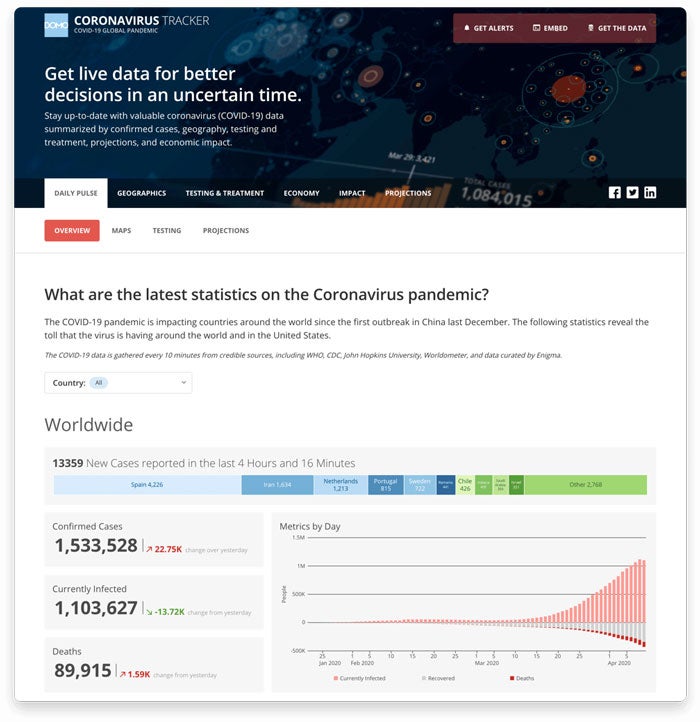
Domo is a cloud-based business intelligence (BI) and data company based in American Fork, Utah, and is part of the state’s Silicon Slopes tech scene. Like any number of tech companies, Domo was forced to move its 2020 user conference online due to the Covid-19 coronavirus pandemic.
It recently brought its data expertise to bear on the outbreak, making global tracking information freely available. Domo vice-president of data curiosity Ben Schein gave Verdict an overview of the company and its contribution to the fight against coronavirus.
Berenice Baker: What does Domo do and what makes it unique?
Ben Schein: Domo’s core value proposition is this idea of BI leverage at cloud scale in record time. A lot of my work is about driving culture change and how people use data, not just buying the best tool. In in the past, we would just buy these different solutions and somehow it felt like, no matter what, it never added up to actual value. We were just frustrated that can’t get what I need, that data’s not useful, it’s too slow. That’s a lot of the core emotional problem I think we solve.
The Genesis story for Josh James, our CEO and founder, is that this is the second company that he’s taken public on NASDAQ; he took Omniture public and sold it to Adobe for a lot of money. One of the things that bugged him running Omniture was that he was running one of the largest data compilers, one of the first SaaS companies in the world. But if you wanted to know anything about his business, beyond just the web data that he was collecting, it never seemed easy.
The core of the product was this idea of, I have Facebook, I have this device that can tell me what someone’s eating next door for dinner. And yet if I want to know how much money I have in my bank account, or to know what my AWS bill is, I can’t get it. He set out with that core problem in mind and it ended up being way more complicated than I think he ever thought. Moving data from silos into Cloud was exploding as we started to make those developments.
The reason that we can deliver the BI leveraging at cloud scale in real time is built with this idea of how do I bring data together across silos, across different kinds of data. What we’re seeing with our customers is that not all data is created equal. Not all data is in the well-engineered data lake; some of it’s in a cloud system, like Workday, or some of it might be in an Excel spreadsheet. And if I’m running a business, that Excel spreadsheet can be as important as what in my data lank.
How well do you really know your competitors?
Access the most comprehensive Company Profiles on the market, powered by GlobalData. Save hours of research. Gain competitive edge.

Thank you!
Your download email will arrive shortly
Not ready to buy yet? Download a free sample
We are confident about the unique quality of our Company Profiles. However, we want you to make the most beneficial decision for your business, so we offer a free sample that you can download by submitting the below form
By GlobalDataEach one of those systems is visualising their own data, but that’s not your business. Those are silos of our business; your business is how you bring all those together and that’s when you actually start seeing your value from data.
How is Domo lending its services to help fight the Covid-19 coronavirus pandemic?
We’re relaunching our tracker website with new interaction and even more data. A lot of what I described before in terms of BI leverage, in terms of how we really change companies, this whole situation is all of that flexibility on steroids. Business always has to react to unexpected changes in the market, but the amount of change that occurred at once has shocked people in different ways.
To start with, it was just, hey, we want to help people better understand the information that’s out there and be more exploratory and more interactive. Some of the initial work we’ve done with the tracker was about okay, we have a platform that lets us bring lots of data together, that makes it easy to use and more interactive. So part of it was how do we make it more interactive and very much mobile-first.
I think a lot of our work has been some of the better than a lot of other websites. We’re all using common data, but other websites where they had a mobile version it had just three metrics or wasn’t easy to see on the phone, and we’re very committed to that. Lastly, something I’ve been passionate about is, because you have that public tracker, it can be embedded as an iframe, so anyone who wants to use the HTML side of it can leverage those cards and use it to drive things.
We are also making all that data available to our customer base. If I’m a health insurance company, I can pull in that data and combine it with information on my call centre and claims I’m seeing or have a hospital in Missouri I can pull that in and let my leaders understand how we are responding if we have five hospitals across four states. That’s where you see a lot of the value that’s been exciting to see our customers be able to use it. We have this flexibility because it was built with low-code engineering and the ability to move and blend data easily, whereas with other systems in the past maybe you needed an engineer.

What trends in business information are you seeing?
Through working on the data pipeline for the corona tracker I’ve seen this idea of using data to manage your data and your data teams. You often don’t have a budget for a tool for your own team; your budget is supposed to be for the business, but the power of having something flexible like Domo is you can actually use it to also manage those components, like data quality.
I get alerts in the morning if Worldometer has a new country that Johns Hopkins hadn’t listed for coronavirus, or we’re tracking multiple sources of different reported coronavirus cases so that we can monitor if something’s flipping there, or using data about usage within Domo to understand what your users are doing.
Another trend that gets overlooked is I used to tell my team run your data like a website; how many people are looking at this, how many times are they repeating, how many times are they exiting? I continue to see is this idea of how to use data to render data, and making sure you don’t forget about that part.
Read more: Coronavirus case studies: How Thales is lending cybersecurity might to NHS Wales




